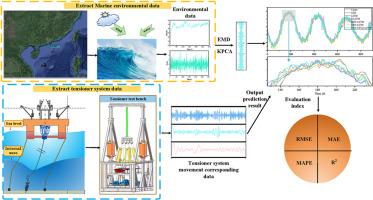内波下浮式平台水气张紧器系统的在线预测
IF 7.5
2区 计算机科学
Q1 AUTOMATION & CONTROL SYSTEMS
Engineering Applications of Artificial Intelligence
Pub Date : 2024-11-15
DOI:10.1016/j.engappai.2024.109656
引用次数: 0
摘要
针对目前浮动平台拉伸器系统运动响应预测模型精度较低的问题,本文提出了一种集成了经验模式分解(EMD)、核主成分分析(KPCA)和长短期记忆(LSTM)的在线预测方法。EMD 技术用于分解环境因素序列,减少其非平稳性。随后,利用 KPCA 提取关键影响因素并降低输入维度。最后,应用 LSTM 神经网络捕捉特征中的长期依赖关系,并做出准确预测。通过使用拉伸器平台装置在有内波和无内波两种情况下的运动响应数据对模型进行验证,并与其他模型进行比较。结果表明,EMD-KPCA-LSTM 模型在两种情况下都具有很高的预测精度。其中,与卷积神经网络(CNN)模型相比,系统位移和拉力的平均均方根误差(RMSE)、平均绝对误差(MAE)和平均绝对百分比误差(MAPE)分别降低了 52.97%、55.14%、56.31%、68.97%、71.02%、57.60%,R 平方(R2)分别提高了 7.14%和 12.37%。综上所述,该模型具有良好的数据拟合能力和较高的预测精度,具有重要的实用价值。本文章由计算机程序翻译,如有差异,请以英文原文为准。

Online prediction of hydro-pneumatic tensioner system of floating platform under internal waves
To address the issue of low accuracy in the current motion response prediction model of the floating platform tensioner system, this paper proposes an online prediction method that integrates Empirical Mode Decomposition (EMD), Kernel Principal Component Analysis (KPCA), and Long Short-Term Memory (LSTM). The EMD technique is employed to decompose the sequence of environmental factors, reducing their non-stationarity. Subsequently, KPCA is used to extract key influencing factors and reduce input dimensionality. Finally, LSTM neural networks are applied to capture long-term dependencies in features and make accurate predictions. By validating the model using motion response data from the tensioner platform device under two scenarios with and without internal waves, it is compared against other models. The results show that the EMD-KPCA-LSTM model has high prediction accuracy in both scenarios. In particular, compared with the Convolutional Neural Network (CNN) model, the mean Root Mean Square Error (RMSE), Mean Absolute Error (MAE) and Mean Absolute Percentage Error (MAPE) of the displacement and tension of the system decreased by 52.97%, 55.14%, 56.31%, 68.97%, 71.02% 57.60%, respectively, and R-square (R2) increased by 7.14% and 12.37%. In summary, the model has a good ability for data fitting and high prediction accuracy and has important practical value.
求助全文
通过发布文献求助,成功后即可免费获取论文全文。
去求助
来源期刊

Engineering Applications of Artificial Intelligence
工程技术-工程:电子与电气
CiteScore
9.60
自引率
10.00%
发文量
505
审稿时长
68 days
期刊介绍:
Artificial Intelligence (AI) is pivotal in driving the fourth industrial revolution, witnessing remarkable advancements across various machine learning methodologies. AI techniques have become indispensable tools for practicing engineers, enabling them to tackle previously insurmountable challenges. Engineering Applications of Artificial Intelligence serves as a global platform for the swift dissemination of research elucidating the practical application of AI methods across all engineering disciplines. Submitted papers are expected to present novel aspects of AI utilized in real-world engineering applications, validated using publicly available datasets to ensure the replicability of research outcomes. Join us in exploring the transformative potential of AI in engineering.
 求助内容:
求助内容: 应助结果提醒方式:
应助结果提醒方式:


